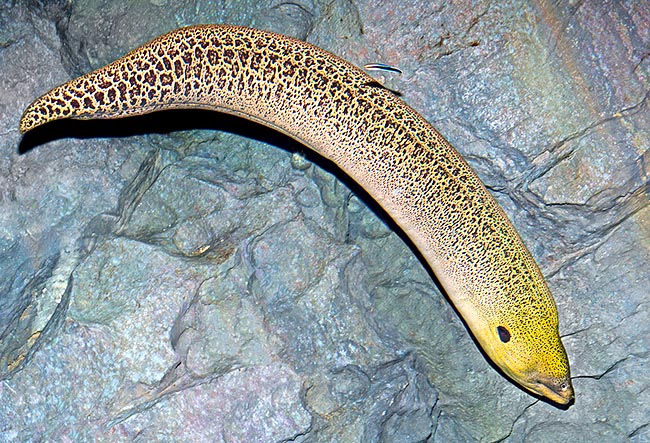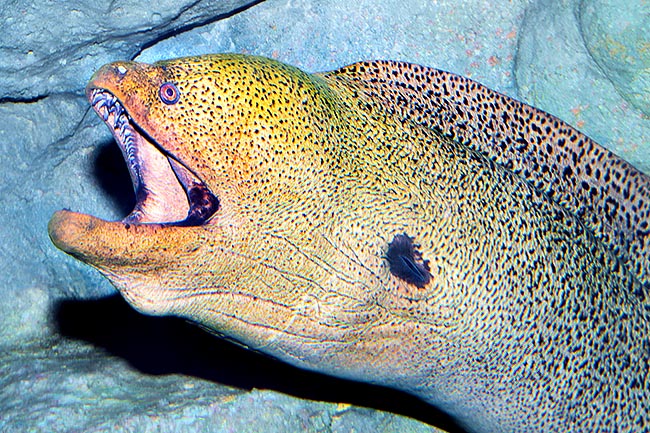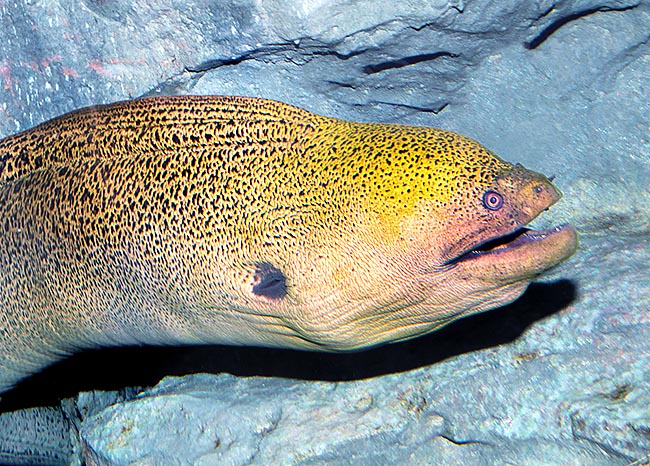Family : Muraenidae

Text © Giuseppe Mazza

English translation by Mario Beltramini

Gymnothorax javancus can exceed 3 m and 24 kg of weight with a record of 70 kg © Giuseppe Mazza
The name of the genus Gymnothorax comes from the Greek “gymnos”, naked, and from the Latin “thorax”, thorax, with reference to the fact that unlike eels the thorax has no pectoral fins and therefore is naked.
The name of the species javanicus in Latin, “of Java” evokes the island of Java, where it is very common.
Zoogeography
It has a very vast distribution in the tropical waters of the Indian and Pacific oceans. Indicatively, we find it from South Africa and Madagascar up to the Red Sea and the Arabian Sea, the Seychelles, the Maldives, in India, in Sri Lanka, at the Andaman Islands, in Thailand, Malaysia, Indonesia, Cocos Islands, Christmas Island, Australia, in the southern hemisphere of the Pacific Ocean, in New Caledonia, and the Marquesas Islands with the other Austral islands.
Ecology-Habitat
It lives among the madreporic formations, on the outer side of the reefs and in the cracks of the rocks on the precipices up to 50 m of depth. The juveniles usually grow up in the calm and shallow waters of the lagoons.

Solid lines of sharp or hooked teeth, also on the palate, to hold and tear the preys © Giuseppe Mazza
It is a big moray which may exceed the 3 m and the 24 kg of weight, with an unbelievable record of 70 kg. The dorsal, caudal and anal fins are merged to form a unique long cutaneous crest on the back prolonging, passing by the tail, up to the anal zone.
As is customary in the morays, the pectoral fins and the ventral one are absent. The body is serpentiform, without scales, protected by slippery mucus which allows the animal to pass through narrow spaces.
The eyesight is poor, but it has four nostrils shaped like a small tube with vibrating cilia for a perfect circulation of the water and of the information. The first two, over the snout, are bent forward and the others, over the eyes, look on the back in order to get a perfect perception all around. As a consequence, the sense of smell is exceptional, much more useful than the eyes when hunting at night.
The branchial orifices are reduced to simple holes, at the centre of two dark spots placed at the end of the head on the alignment of the jaws. The mouth, with an enormous opening, shows also on the palate solid rows of sharp or hooked teeth for holding and tearing off the preys. On the brown-yellow-reddish background colour, stand out countless dark spots of various size. Tiny on the head and almost absent on the ventral zone, they get bigger and more marked towards the back and the tail.
Ethology-Reproductive Biology
The Gymnothorax javanicus hunts mainly fishes, but also benthic crustaceans such as lobsters and crabs.

The branchial opening is a hole surrounded by a dark spot. Endangered species © Giuseppe Mazza
It strikes with force and due to its size, the hunters in apnoea may be held under water and die drowned. Even if the saliva of the morays is more or less toxic, there is no venom on the bites, but the wounds convey dangerous pathogen agents due to the alimentary substances decaying between the teeth.
Finally, the flesh of the oldest specimens is toxic, because the giant moray accumulates, day after day, the toxins of the herbivorous fishes nourishing of poisonous seaweeds in their tissues. He who eats it risks a severe alimentary intoxication, called ciguatera.
The Gymnothorax javanicus often lives in symbiosis with some shrimps that, in exchange of the food leftovers, clean up its teeth and remove the parasites of the skin.
The eggs are pelagic and the larvae, called leptocephali, are transparent thin stripes, shaped like a leaf of willow, with a very small head. This is an archaic character in the world of the fishes. This larval phase is very long and may last even one year.
The growth is slow, and notwithstanding the ample diffusion, it is an endangered species, with a vulnerability risk of 84 on a scale of 100.
Synonyms
Muraena javanica Bleeker, 1859; Lycodontis javanicus Bleeker, 1859.
→ For general information about FISH please click here.
→ For general information about BONY FISH please click here
→ For general information about CARTILAGINOUS FISH please click here.
→ To appreciate the BIODIVERSITY of BONY FISH please click here.
→ To appreciate the BIODIVERSITY of CARTILAGINOUS FISH please click here.
